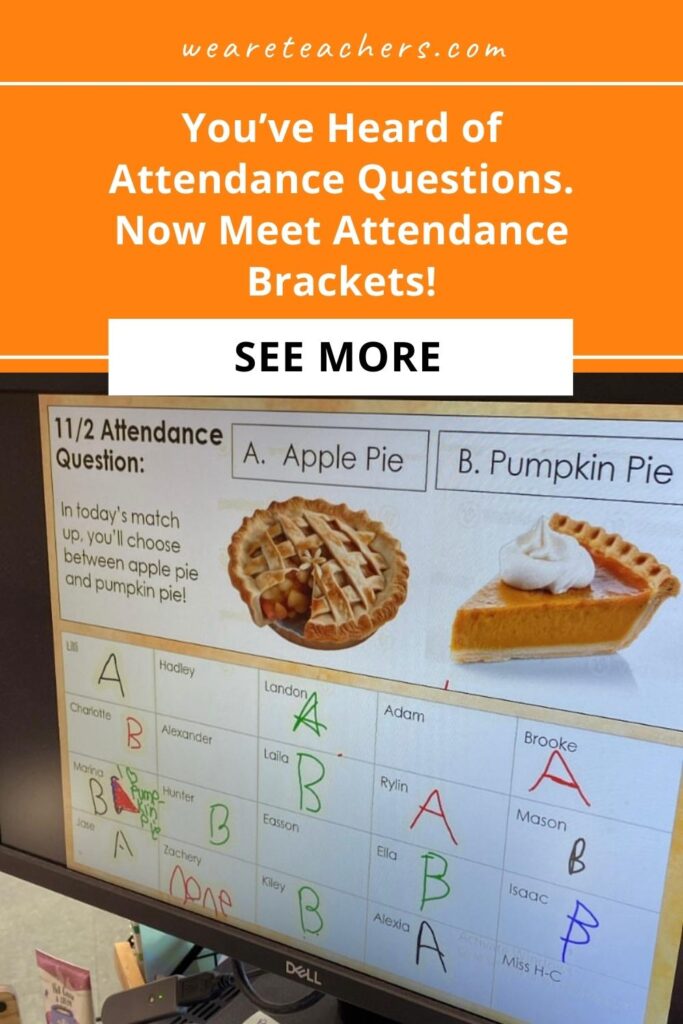Like many of my favorite routines in my classroom, attendance brackets are not an original creation. I was introduced to them by a colleague and dear friend. When she moved to a new district at the beginning of the school year, I was quick to grab the idea as a way to remind myself to submit attendance. What started as a reminder to complete a daily task soon became a treasured way to connect with students and build classroom community.
If you’re not yet familiar with attendance questions, I recommend checking out this article first. If you already know how they work or are using them in your classroom, keep reading for a fun and competitive way to switch it up.
Building Your Bracket
Setting up an attendance bracket is simple. Your first step is to select a topic. Ideal bracket topics are ones that all students will have had the opportunity to engage with. In secondary classrooms, they can also be a way to acknowledge student excitement around holidays that may not otherwise be celebrated. My first bracket was Halloween Candy–themed, and it was followed by Thanksgiving side dishes. My aforementioned coworker also did brackets featuring fruits, breakfast cereals, Disney villains, and pizza toppings.
Now that you have a topic, you’ll need to build your bracket. The internet has plenty of premade brackets to choose from. My Halloween Candy bracket started as this one from the Today show. However, my kids had strong opinions about the candies they wanted included. While their logic was questionable (the arguments included statements like ”only old people eat Butterfingers” and “Mounds are too healthy”), replacing some of the original options with their choices allowed them to see themselves reflected in the bracket. Ultimately, this made for more authentic engagement. I learned my lesson and allowed the kids to select the starting lineup for the Thanksgiving Dishes bracket.
To construct the bracket, I found a blank 16-team bracket and set it as the background in a Google Slide. A 16-team bracket will take just under a month if you have students vote on one matchup today. Eight- and four-team brackets allow for faster completion and could be a good way to introduce brackets to your students. Finally, fill in your starting lineup with text boxes, images, or both. I print my brackets on 11 x 17-inch paper and display them in my classroom.
Let the games begin!
Now you’re ready to run your bracket! I have a bracket slide that greets my homeroom students when they enter class each morning. Each student has a space with their name to write their vote using the interactive whiteboard. At the end of homeroom, votes are counted and our large bracket is filled in. It’s worth noting I only run brackets with my homeroom, but this system could easily be adapted for multiple class periods. The beauty of the slide is that it actually reminds me to take attendance—I literally can’t project the first slide for class until I’ve cleared the writing from the bracket slide. The daily reminder means my days of being called to submit my attendance are a thing of the past.
Other options for running the bracket could be a word cloud generator like Mentimeter, a Google Classroom question, a Google Form, or a good old-fashioned verbal share-out. There’s no wrong way to do it, so experiment and find what works in your classroom.
Up for a challenge?
One final consideration: Do you want to make your bracket competitive? I offered my students the opportunity to fill out a blank Thanksgiving bracket. It was a fun way to kick off the bracket and didn’t become overwhelmingly competitive. I can see that this wouldn’t have been the case with other groups of students I’ve taught. You know your kids best, so proceed cautiously.
Blending Competition and Community
Since beginning attendance brackets, I have seen a change in how my students enter homeroom. They’re excited to cast their votes, debate the merits of important topics (yes, middle schoolers consider dinner rolls versus cornbread important), and, most importantly, engage with one another. It gives me a way to start conversations with even my quietest students, many of whom I’ve seen become more relaxed and comfortable as the year unfolds. I’ve even learned important things about my students’ families and their holiday traditions. Now, the only question is what will claim the top spot in December’s Holiday Cookie and Dessert bracket? I’ll be pulling for gingerbread cookies!
For more content like this, be sure to subscribe to our newsletters!


